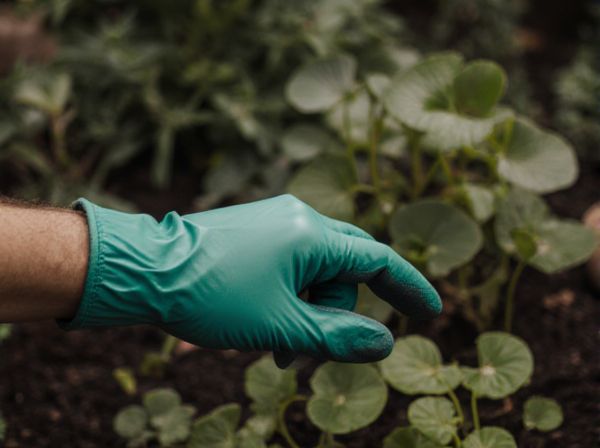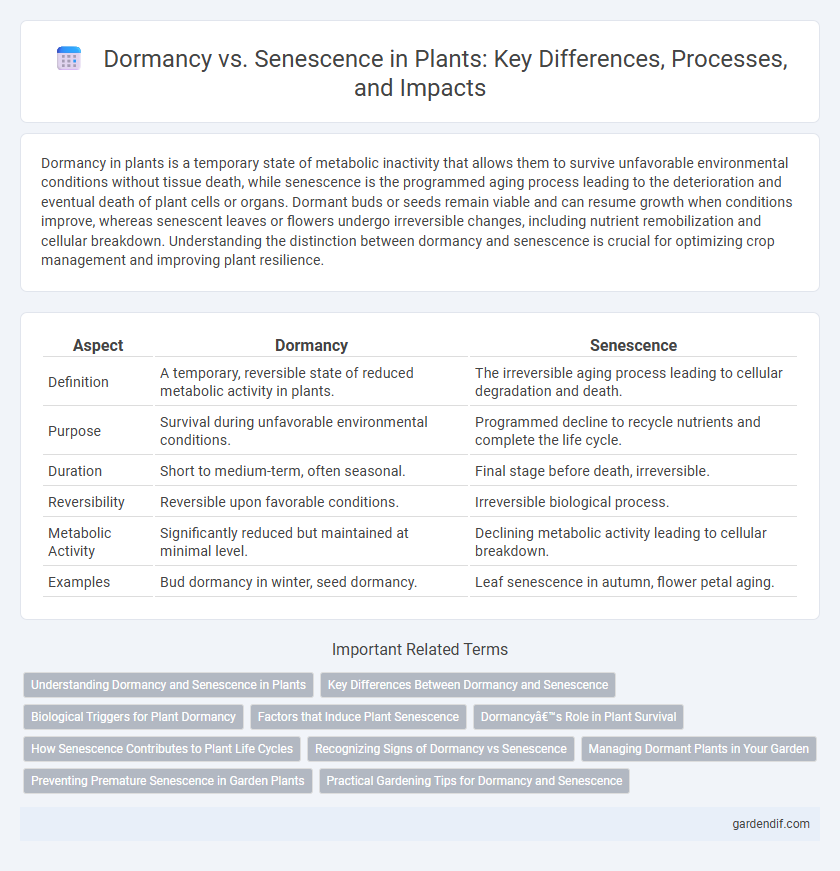
Dormancy vs Senescence Illustration
Dormancy in plants is a temporary state of metabolic inactivity that allows them to survive unfavorable environmental conditions without tissue death, while senescence is the programmed aging process leading to the deterioration and eventual death of plant cells or organs. Dormant buds or seeds remain viable and can resume growth when conditions improve, whereas senescent leaves or flowers undergo irreversible changes, including nutrient remobilization and cellular breakdown. Understanding the distinction between dormancy and senescence is crucial for optimizing crop management and improving plant resilience.
Table of Comparison
| Aspect | Dormancy | Senescence |
|---|---|---|
| Definition | A temporary, reversible state of reduced metabolic activity in plants. | The irreversible aging process leading to cellular degradation and death. |
| Purpose | Survival during unfavorable environmental conditions. | Programmed decline to recycle nutrients and complete the life cycle. |
| Duration | Short to medium-term, often seasonal. | Final stage before death, irreversible. |
| Reversibility | Reversible upon favorable conditions. | Irreversible biological process. |
| Metabolic Activity | Significantly reduced but maintained at minimal level. | Declining metabolic activity leading to cellular breakdown. |
| Examples | Bud dormancy in winter, seed dormancy. | Leaf senescence in autumn, flower petal aging. |
Understanding Dormancy and Senescence in Plants
Dormancy in plants is a survival strategy that temporarily halts growth and metabolic activities to withstand unfavorable environmental conditions, such as cold winters or drought. Senescence is the programmed aging process where cells and tissues undergo systematic degradation leading to death, often associated with nutrient recycling and seasonal changes. Understanding the distinct physiological and molecular mechanisms of dormancy and senescence helps optimize crop management and improve plant resilience.
Key Differences Between Dormancy and Senescence
Dormancy in plants is a temporary, reversible state of metabolic slowdown that helps survive unfavorable environmental conditions, while senescence is the irreversible aging process leading to the death of cells or organs. Dormancy primarily affects buds, seeds, or tubers enabling growth resumption, whereas senescence involves chlorophyll degradation, nutrient recycling, and programmed cell death. These distinct processes play crucial roles in plant lifecycle management and stress adaptation strategies.
Biological Triggers for Plant Dormancy
Plant dormancy is triggered by environmental cues such as decreasing photoperiod, lower temperatures, and water scarcity, which induce hormonal changes like increased abscisic acid levels and reduced gibberellin production. These biological signals suppress metabolic activities and growth processes, allowing plants to conserve energy during unfavorable conditions. In contrast, senescence involves a genetically programmed degradation phase marked by increased ethylene and cytokinin decline, leading to the aging and eventual death of plant tissues.
Factors that Induce Plant Senescence
Environmental stressors such as drought, extreme temperatures, and nutrient deficiency are primary factors that induce plant senescence by triggering hormonal changes and oxidative stress. The accumulation of ethylene, abscisic acid, and cytokinins imbalance accelerates senescence processes, leading to chlorophyll degradation and nutrient mobilization. Genetic regulation involving senescence-associated genes (SAGs) also plays a crucial role in coordinating the onset and progression of senescence in plants.
Dormancy’s Role in Plant Survival
Dormancy in plants is a crucial adaptive mechanism that temporarily halts growth and metabolic activity, allowing survival during unfavorable environmental conditions such as extreme cold or drought. This physiological state conserves energy and protects vital tissues, enabling plants to resume normal function when conditions improve. Unlike senescence, which marks irreversible aging and decline, dormancy is reversible and essential for perennial plant survival and seasonal growth cycles.
How Senescence Contributes to Plant Life Cycles
Senescence in plants facilitates nutrient recycling by breaking down cellular components, enabling the redistribution of essential elements like nitrogen and phosphorus to developing seeds and new tissues. This process enhances reproductive success and ensures resource efficiency during critical life cycle stages. Unlike dormancy, which is a temporary metabolic slowdown to survive unfavorable conditions, senescence marks a programmed degradation phase contributing to the plant's aging and lifecycle completion.
Recognizing Signs of Dormancy vs Senescence
Dormancy in plants is characterized by a temporary halt in growth, evidenced by closed buds, reduced metabolic activity, and no visible leaf yellowing, which helps them survive unfavorable conditions. Senescence involves the gradual aging process marked by yellowing or browning leaves, nutrient relocation, and cellular degradation leading to eventual organ death. Accurately distinguishing dormancy from senescence is crucial for effective plant care, as dormancy signals potential regrowth, while senescence indicates irreversible decline.
Managing Dormant Plants in Your Garden
Managing dormant plants in your garden involves maintaining appropriate soil moisture and protecting roots from extreme cold to ensure healthy regrowth. Pruning dead or damaged branches during dormancy reduces disease risk and promotes vigorous spring growth. Applying a layer of mulch helps regulate soil temperature and conserves moisture, supporting overall plant health throughout the dormant period.
Preventing Premature Senescence in Garden Plants
Dormancy in garden plants is a natural resting phase that allows survival during unfavorable conditions, while senescence involves the aging and eventual death of plant tissues. Preventing premature senescence can be achieved by ensuring optimal watering, balanced fertilization with essential nutrients like nitrogen and potassium, and minimizing environmental stress such as extreme temperatures and pest damage. Implementing mulching techniques and pruning also supports prolonged plant vitality by maintaining proper energy reserves and reducing disease susceptibility.
Practical Gardening Tips for Dormancy and Senescence
Understanding dormancy and senescence is crucial for effective plant care, as dormancy refers to a temporary pause in growth, while senescence marks the natural aging and decline of plant tissues. Practical gardening tips include reducing watering and withholding fertilizers during dormancy to conserve energy, whereas during senescence, it's important to prune dead or yellowing leaves to prevent disease and promote healthy regrowth. Employing mulch can protect roots through dormant periods, and monitoring senescent plants for pests helps maintain overall garden health.
Dormancy vs Senescence Infographic

 gardendif.com
gardendif.com